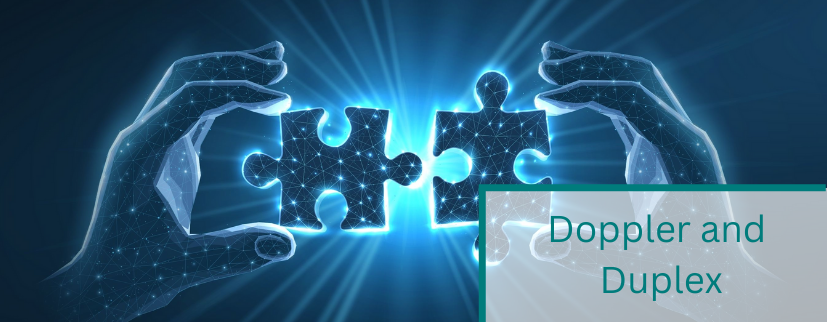
10 Jul 2023 Doppler and Duplex
Doppler as a complementing method to Duplex
Transcranial Doppler Sonography (TCD) and Transcranial Color Duplex Sonography (TCCD) are complementary diagnostic methods. The diagnosis of stenoses can be made with conventional TCD with the help of higher sensitivity in the velocity measurement. Complementary to this, however, TCCD enables a more precise localization of the stenosis.
In addition, TCD also offers the following advantages over TCCD
User-friendly design
Compared to Duplex devices, TCD systems are much easier to handle and more compact. In addition, TCD systems are equipped with a remote control, which enables a fast and efficient examination procedure. This allows convenient operation of the parameters while simultaneously guiding the Doppler probe. In a Duplex examination, the parameters are set via the control panel fixed on the device, which makes simultaneous measurement with the probe more difficult.
Better insonation: smaller contact area = greater success rate
Independent studies have shown that imaging systems only achieve a 50-70% successful insonation rate (ability to derive signals). In comparison, stand-alone TCD systems have a success rate of at least 90%.
The middle to distal basilar artery is more difficult to find with Duplex systems because their probe has a larger contact area, making the insonation angle less flexible to adjust than with hand-held Doppler probes.
Compared to the TCCD probe (Linear Array Probe or Phased Array Probe), the hand-held Doppler probe has a smaller contact area.
This allows easier and more precise adjustment of the Doppler beam angle of incidence, resulting in significantly better velocity measurement.
Lower risk due to low power output/power
The power output of a TCCD probe is much higher than that of a Doppler probe. It can lead to a biologically significant increase in temperature in the tissue being transmitted.
Hence, for example, a transorbital approach is not recommended for TCCD.
Extensive screening programs and documentation
A variety of additional diagnostic tools in the TCD systems make it easier for clinical staff to make accurate diagnoses:
● Special features for routine diagnostics
● Specific Sickle Cell diagnostic
● Lindegaard Ratio Index
● Brain death diagnosis
● Vasotrend in vasospasm after subarachnoid hemorrhage
● ABI (Ankle Brachial Index)
TCD systems include multiple report options and an offline version for later review.
Monitoring applications and long-term monitoring with probe fixation
The bilateral capabilities of TCD allow the simultaneous assessment of the right and left hemisphere by, for example:
● Bilateral long-term monitoring in the intensive care unit, operating theatre and stroke unit
● Emboli detection as well as differentiation and evaluation
● PFO test protocol and report documentation according to the ESNCH 1999 consensus committee
● Special functional tests such as CO2/VMR, Evoke Flow
They eliminate the need to repeat contralateral tests which are required with TCCD.
A typical monitoring function test takes about 20 minutes; a continuous monitoring recording with emboli detection during an operation, for instance, in the course of carotid endarterectomy, takes several hours.
Whereas with TCCD, the probe would have to be held for the entire duration, with TCD the various mounting devices for monitoring or hand-held probes specially developed for DWL enable a constant signal from the probe – without shifting or shaking. This is what makes monitoring possible in the first place, such as, during an operation.
Literature
Transcranial Doppler in Acute COVID-19 Infection
Wendy C Ziai et al., Stroke 2021; 52:2422–2426.
Pulmonary Vascular Dilatation Detected by Automated Transcranial Doppler in COVID-19 Pneumonia
Alexandra S. Reynolds, Alison G. Lee, Joshua Renz, Katherine DeSantis, John Liang, Charles A. Powell, Corey E. Ventetuolo, Hooman D. Poor; American Journal of Respiratory and Critical Care Medicine, 2020, Volume 202, Issue 7.
Symptomatic intracranial atherosclerotic disease: an ultrasound 2-year follow-up pilot study
Pietro Caliandro, Giuseppe Reale, Andrew M. Demchuk, Valeria Caso, Anita Arsovska, Chiara Iacovelli, Silvia Giovannini, Paolo Maria Rossini; 2018.
Transcranial Doppler Ultrasound: Technique and Application
Sushmita Purkayastha, Farzaneh Sorond; 2012.
Carotid Artery Wall Thickness in Patients With Obstructive Sleep Apnea Syndrome
